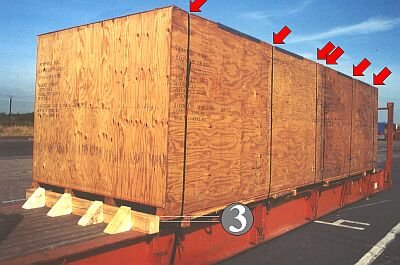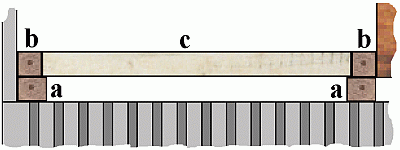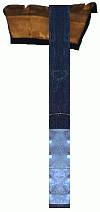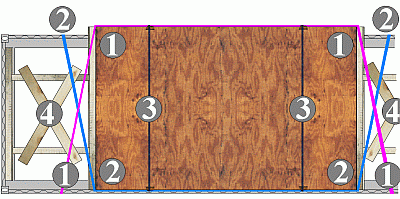Two plywood cases on a 40' flatrack
Without performing any calculations, it is obvious that the securing means provided are inadequate.
 |
|
| Inadequately secured cases on a 40' flatrack - side view |
The two plywood cases each weigh 4,000 kg and are each 4.10 m long, 2.50 m wide and 2.20 m tall. Their eccentric center of gravity is labeled as required and is relatively low (at (1) and (2) in the Figure).
 |
|
| Inadequately secured cases on a 40' flatrack - oblique view |
The three steel straps used per case lose their pretension if they cut any further into the outside of the case and are then no longer able to fulfill their holding-down function. They then act as pre-loosened direct lashings predominantly only in the vertical direction.
In each case, three nails have been hammered into the four wedges, but they do not provide adequate lengthwise securing. In particular, the nails can be easily levered out of the wedges, since the wooden crosspiece laid between case and wedges has only a very low effective height (3).
Appropriate lengthwise securing can be achieved by stowing the cases so that their centers of gravity are symmetrical and blocking them against the end walls:
 |
|
| Variant for lengthwise securing of two cases using wooden bracing | |
 |
|
| Detail of wooden bracing |
In order to be able to provide bracing in the load-bearing bottom area of the cases using bracing lumber, two crosspieces (a) are placed in front of the end walls of the flatrack and the cases. The height of these wooden members must match that of the case props. Two further crosspieces (b), which must be somewhat narrower than the crosspieces (a) are placed on the crosspieces (a), to produce an appropriate abutment for the bracing consisting of the precisely fitting wooden members (c). All the wooden members must be attached to one another and the wooden members (a) to the flatrack floor. If necessary, the wooden members (c) must be X-braced together with wooden boards.
So as not have to rely on tie-down lashings for transverse securing of the cases, it is better to space them from one another and to block them:
 |
|
| Variant for lengthwise securing of two cases using wooden bracing | |
The method of stowing the case is different from that originally used: the cases overhang on only one side, not both, so that only two slots are occupied instead of three.
 |
|
| Securing of overwidth, overheight cases - side view |
| Appropriate transverse securing can be achieved using loop lashings passed around the sides. These would provide sufficient securing if the center of gravity of the cases is very low, but to avoid any risk it is advisable also to fit two steel strapping tie-down lashings per case to secure against tipping. To ensure that the steel strapping is adequately pretensioned and to prevent it from cutting into the outsides of the boxes, the steel strapping should be passed over automobile tire segments. |  |
| Steel strapping for tie-down lashings tensioned over an automobile tire segment |
Detailed view:
 |
|
| Expert securing of overwidth, overheight cases - detailed plan view |
1 and 2 = horizontally arranged loop lashings for lateral securing
3 = tie-down lashings for securing against tipping
4 = X-bracing of wooden bracing